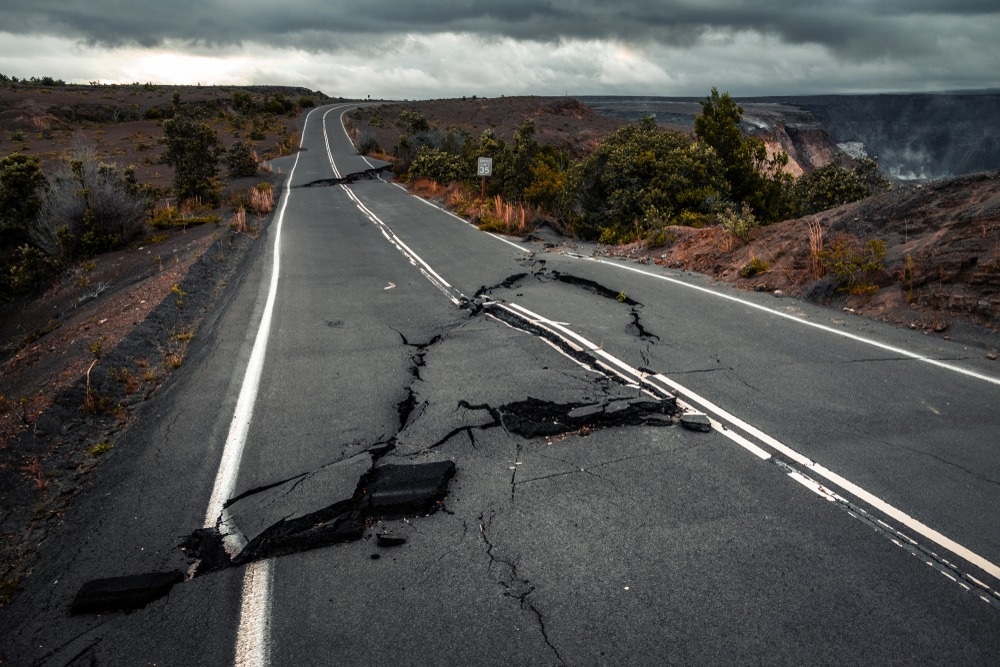A study published in the journal Nano Energy proposed using TENGs having an inertial mass on their surface as self-powered seismic detectors (SEIS-TENGs) for earthquake monitoring. The SEIS-TENGs would enable the measurement of ground vibrations to avert disasters caused by earthquakes.

Study: High-resolution TENGS for earthquakes ground motion detection. Image Credit: Dudarev Mikhail/Shutterstock.com
What is Earthquake Monitoring?
In the most basic sense, Earthquake tracking is the collection of fundamental earthquake data, including location, occurrence time, and severity from sustained seismic waveforms. Seismic monitoring focuses not just on major earthquakes but also on minor ones with vibrational amplitudes that humans cannot detect.
Recent advances in earthquake monitoring have mostly occurred in two fields: seismic equipment and data processing methods, resulting from the expansion of the manufacturing sector and computer science.
Different Technologies for Sensing Earthquakes
Various earthquake detectors have been installed in different networks across the world. Broadband, highly sensitive, and strong-motion seismographs are usually fitted with short-period speed seismometers, tiltmeters, and accelerometers, which form permanent earthquake monitoring networks.
These devices are set up on the ground within tiny rooms or buildings, with their data acquisition systems (DAQs) and integrated electronics, in seismically active areas.
Vast N-arrays, distributed acoustic systems (DAS), and microelectromechanical systems (MEMS) use many sensors dispersed across many kilometers.
Fiber optic monitoring is constant, relying on light backscatter as it travels down the fiber and meets crystal imperfections or heat changes.
All these earthquake sensors form a large network of linked devices that communicate through Wi-Fi, GPS, and GSM.
Limitations of Existing Earthquake Sensors
These earthquake sensors, unfortunately, have certain drawbacks: mobile phone MEMS are not ideal for detecting minor earthquakes, while high precision MEMS are costly and become saturated with strong movement.
DAS is unable to monitor seismic activity at distances greater than 100 kilometers, and their node grids cannot monitor deeper seismic events.
Conventional seismometers disregard rotational movements, and high-resolution seismometers require expensive and complex equipment.
Fiber optic monitoring systems can cover considerably greater distances than DAS and are effective in detecting major and moderate-intensity earthquakes. However, they have poor spatial resolution and cannot reliably locate specific seismic events.
High-tech continuous seismic networks are costly, with unit separations in the sub-kilometer range. Highly accurate and sensitive temporary networks entail long shipment and installation times. This means that crucial seismic activity following the primary shock could be missed.
Innovative earthquake sensors integrated into the form of a complete system that can overcome these constraints are, therefore, the focus of current seismological research.
What Did the Researchers Do?
TENGs (triboelectric nanogenerators) are highly sensitive to mechanical stresses. Moreover, they have excellent mechanical-electrical conversion performance, customizable size, and low expenses.
The team presented TENGs as earthquake sensors in this study. The goal was to discern various forms of seismic waveforms and ultimately to monitor different ground vibrations.
Six distinct kinds of TENGs were examined, and the TENG having the greatest responsiveness was identified and utilized in subsequent proof-of-principle tests.
Artificial vibrations are having sinusoidal excitation frequencies as high as 50 Hz were created using hydraulic-mechanical and electromechanical oscillation testing devices.
CEDEX used a three-axis vibrating table to simulate eight different earthquakes. In the experiments, all the generated earthquakes created a combination of frequencies in the three dimensions of space.
Results of the Study
TENG-based PVA10PPAPEI/PVDF and Paper/PDMS were found to have the greatest and weakest sensitivity, respectively. The TENGs' signals were successfully delivered wirelessly utilizing long-range communication protocols.
The inexpensive TENG based on Paper/PDMS was utilized to build an earthquake sensor, and its capacity to monitor ground vibrations was evaluated and compared against MEMS-based accelerometers, the most responsive technology currently used in earthquake monitoring networks.
Analyzing data of the signals recorded by the developed SEIS-TENGs and the GURALP accelerometer enabled the team to obtain parameters relevant to seismological studies, including displacement, acceleration, and velocity. This was achieved by passing the raw signals in the frequency range through high pass and low pass band filters.
The results showed that the data obtained by the SEIS-TENGs and the GURALP accelerometer agreed with each other.
In these artificially generated seismic events, a comparable number of earthquakes were detected by the GURALP accelerometer and the SEIS-TENG.
This research demonstrated the practical prospects of employing TENGs as reliable earthquake detectors, with a wide operational frequency domain, the capacity to monitor rapid as well as slow seismic events, and, depending on the raw material used in the TENG, the ability to function in hazardous conditions.
Reference
del Río, J. S., Yusuf, A. et al. (2022). High-resolution TENGS for earthquakes ground motion detection. Nano Energy. Available at: https://www.sciencedirect.com/science/article/pii/S2211285522007443?via%3Dihub
Disclaimer: The views expressed here are those of the author expressed in their private capacity and do not necessarily represent the views of AZoM.com Limited T/A AZoNetwork the owner and operator of this website. This disclaimer forms part of the Terms and conditions of use of this website.